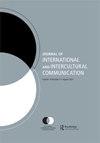Visual slippage: Gouging the colonial eye con Los Punks
IF 2.2
Q2 COMMUNICATION
Journal of International and Intercultural Communication
Pub Date : 2022-06-25
DOI:10.1080/17513057.2022.2088827
引用次数: 0
Abstract
ABSTRACT I analyze Los Punks: We Are All We Have (2016) for three themes that characterize the (im)migrant family, the savage Latinx adolescent, and the colonial hero constructed in represented urban environments. The recorded space in the documentary denotes cultural authenticity while attempting to transform Latinx performances into assimilationist archetypes of Othered (im)migrant subjects. I argue that visual slippage in (im)migrant representation forms an associative relationship composing assimilation narratives created under cultural legitimacy for colonizing eyes gazing at captured (im)migrant life. I add that (im)migrants reciprocate the colonial gaze by confronting it with embodied, visual, and environmental performances affirming lived experiences with non-White viewers—effectively gouging the colonial eye from the reception codes meant to naturalize neocolonial logics.视觉上的滑脱:从洛杉矶朋克身上挖出殖民地的眼睛
本文分析了《洛杉矶朋克:我们拥有一切》(2016)的三个主题,分别刻画了(非)移民家庭、野蛮的拉丁裔青少年和在代表性城市环境中建构的殖民英雄。纪录片中的记录空间表明了文化真实性,同时试图将拉丁裔表演转化为其他移民主体的同化主义原型。我认为,(非)移民表现中的视觉滑移形成了一种联想关系,构成了一种同化叙事,这种叙事是在文化合法性下创造的,即殖民的眼睛凝视着被捕获的(非)移民生活。我补充说,(我)移民通过与非白人观众面对面的具体的、视觉的和环境的表演来回报殖民的目光,这些表演肯定了他们的生活经历——有效地从旨在使新殖民逻辑归化的接待代码中挖出殖民的目光。
本文章由计算机程序翻译,如有差异,请以英文原文为准。
求助全文
约1分钟内获得全文
求助全文
来源期刊

Journal of International and Intercultural Communication
COMMUNICATION-
CiteScore
3.80
自引率
12.50%
发文量
19
 求助内容:
求助内容: 应助结果提醒方式:
应助结果提醒方式:


